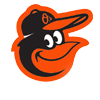The Nationals of the last half-decade boasted as veteran-laden a roster as you'd find in baseball. Yes, there were a handful of young, rising stars mixed in, but general manager Mike Rizzo always made a point to surround them with heavily experienced players who weren't about to get caught up in any moment that became too big for them.
And nowhere on the field was this more true than behind the plate. The Nats featured almost exclusively veteran catchers for years, from Kurt Suzuki to Yan Gomes to Alex Avila to Matt Wieters to Jose Lobaton. In only one season from 2016-20 did they give more than 100 plate appearances to a catcher under 28, and that was a byproduct only of Wieters' prolonged stint on the injured list, forcing Pedro Severino and Spencer Kieboom into regular action.
Some of this was by design, with Rizzo preferring experienced catchers to work with his frontline pitching staff. Some of it was out of necessity, because the Nationals farm system has never really managed to develop its own top-flight catcher.
But as the organization now embarks on a roster rebuild and youth movement, the catching corps looks a whole lot different than it has in a long time, if ever. Barring a surprise addition before opening day, the Nats will enter 2022 with nothing but young catchers, none of them having spent so much as 100 days in the big leagues yet.
 It's no coincidence Rizzo targeted promising young catchers at the July trade deadline. His club had none really to speak of in-house, aside perhaps from Tres Barrera, a sixth-round pick in 2016 draft who impressed this summer when given a chance to regularly play for the first time, but nonetheless still projected as a big-league backup at best.
It's no coincidence Rizzo targeted promising young catchers at the July trade deadline. His club had none really to speak of in-house, aside perhaps from Tres Barrera, a sixth-round pick in 2016 draft who impressed this summer when given a chance to regularly play for the first time, but nonetheless still projected as a big-league backup at best.
So when Rizzo dealt away Max Scherzer and Trea Turner, he wanted the Dodgers' top catching prospect: Keibert Ruiz. And when he traded Brad Hand to the Blue Jays, he got back an intriguing offensive catcher in Riley Adams.
And he didn't stop there. The Gomes-Josh Harrison deal with the Athletics netted (among others) 23-year-old Drew Millas, who spent this season at Single-A and then went to the Arizona Fall League.
Combined with 2020 fourth-round pick Brady Lindsly and 21-year-old international prospect Israel Pineda, the Nationals now have as deep a group of catching prospects as they've ever had. The question is: Will one or more from that group realize his full potential and become a long-term solution in D.C.?
Ruiz, of course, is most likely to fit that description. He was considered the Dodgers' No. 1 overall prospect at the time of the trade, and though it took a few weeks after his arrival here to show it, the 23-year-old did show off the skills that made him so attractive. He has excellent bat control (only four strikeouts in 89 plate appearances after his call-up), gap-to-gap power and a quiet confidence that should only grow as he gains more experience.
Adams came to Washington with less fanfare, but the 25-year-old quickly made a name for himself at the plate, hitting .361/.452/.611 in his first 15 games with the Nationals. He faded down the stretch, going 0-for-11 to end the season, but that may have in part been due to erratic playing time once Ruiz was promoted from Triple-A and began starting almost every day. Even so, Adams still showed a good eye, drawing seven walks during that 0-for-11 slump.
Barrera became the odd man out in September, finishing out the season in Rochester. At 27, he's a bit older than Ruiz and Adams, and could find himself destined for a return trip to Triple-A unless and until someone gets hurt. But he deserves a strong look in spring training and could theoretically beat out Adams for the No. 2 job if he performs well.
Millas, who hit .264/.372/.348 at high Single-A Lansing (pre-trade) and Wilmington (post-trade) is probably headed for Double-A Harrisburg in 2022. Pineda, who hit .208/.260/.389 with 14 homers for Wilmington, may have to repeat at Single-A to begin the season, unless the club decides there are enough at-bats to be shared with Millas at Double-A.
Regardless, the Nationals will enter 2022 with a catching corps that is simultaneously as young and as promising as they've had in a long time. This is unfamiliar territory for this organization, but it's a welcome development for a position that has long needed to be addressed.
LATEST ORIOLES NEWS
LATEST NATIONALS NEWS
By accepting you will be accessing a service provided by a third-party external to https://masn-web.stage.dctinc.net/




